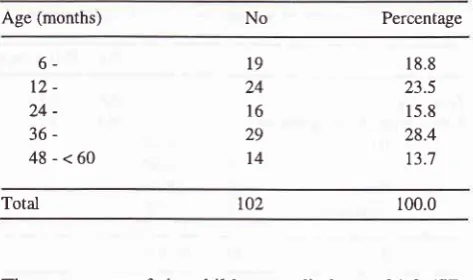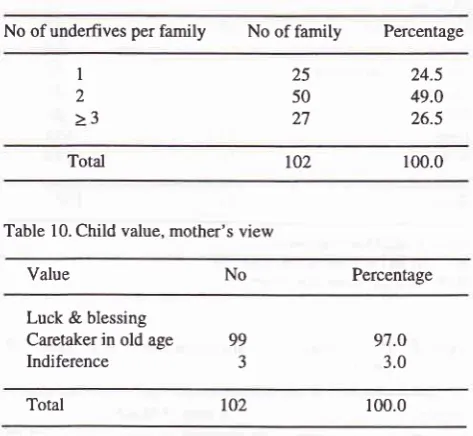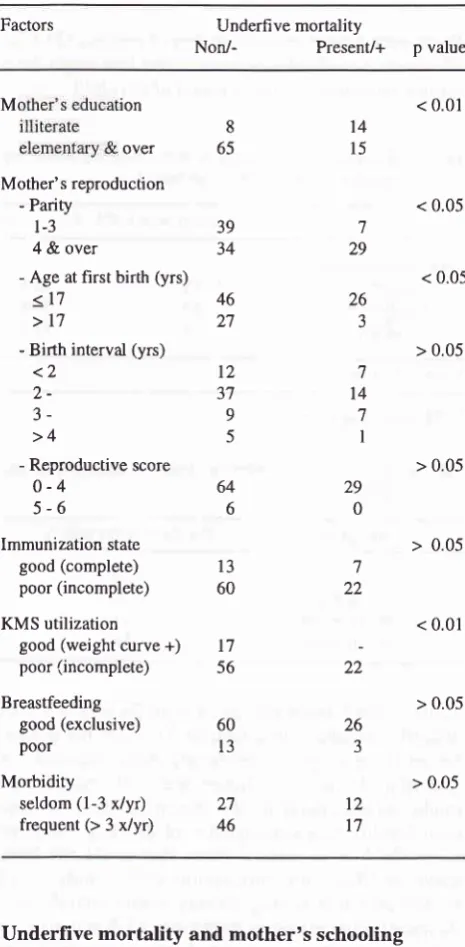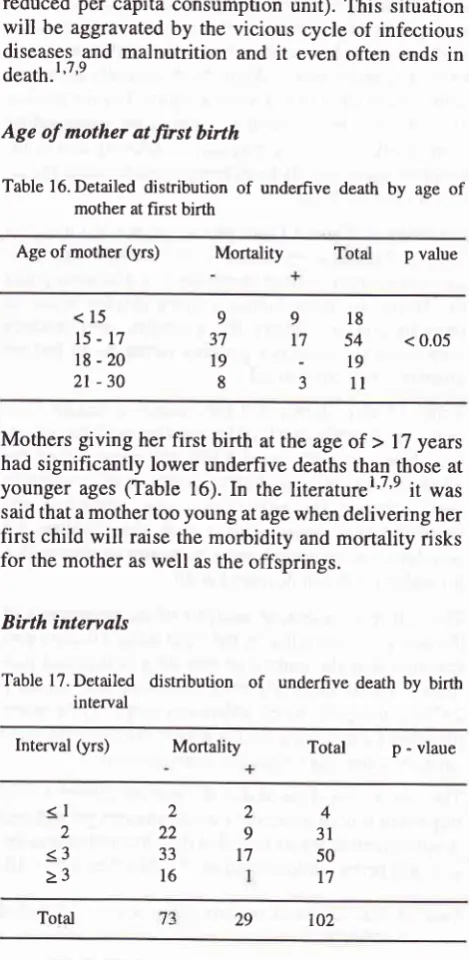2\$
Sdaryo Meà J lnàonesMother's
ProfÏle
and the
fnfant
and Underfïve
Mortality
in
Marunda
North Jakarta
Titi
Sunarwati Sularyo
Abstrak
Telah dilakukan sûatu penelirtan prospektif pada 102 balita dari keseluruhan jurnlah 500 batita di Marunda Jaknrta (Jtara. Fokus penelitian adalah profiI ibu (corak reproduksi dan pendidikan) serta riwayat kemartan balita dalam keluarga. Terdapat ketidal<sesuaian
antara Persepsi ibu tentang corak reprodul<si dengan penerapannya, dalam arti meskipun 55Vo ibu tersebut telah mempunyai persepsi yang baikcorakreprodulcsi namunpenerapanperilakunyayang sesuai hanyaditemukanpada 5.9Vo. Ditemukanbahwacorakreproduksi ibu (terutama aspek paritas dan usia ibu saat melahirkan anak pertama) secara bermalon berhubungan dengan mortalitas balitanya; makin tinggi paritas dan makin muda usia ibu makin besar kemungkinan angka kematian balitanya. Demikian juga ditemukan bahwa pendidikan ibuyang kurang meningkatl<an kematian balita. Dengan memperbaiki pmdidikan ibu dari bun huruf menjadi sekol.ah dasar (nmat maupun tidak) kzmatian balita dapat diturunkan tiga perempatnya. Sangat disayanglan bahwa kedua aspekprofiI ibu tersebut masih sangat kurang. Dengan demikian rtdaÛah mengherankan bahwa angka kematian bayi serta balita pada keluarga tersebut masih tinggi (99.7 dan 154 per 1000 lahir hidup) dibandingl<an dengan angl<a lcematian bayi serta balita umumnya di Indonesia (58 dan 120
per
1000 lahir hidup).Abstract
A prospective study has been conducted on 102 underfives in Marunda, North Jalarta. The Focus of investigation was the mother's profilz (reproductive pattern and schooling) and the underfive mortality- A discrepancy was found between the mother's perception and heradoption ofthe.reproductive pattern, inthe sense that although55Vo ofmothers hada goodperception on reproduction, behavioural adoptian was only 5.97o. Furthermore the mother's reproduction pattem (especially the number of siblings and the age at
rtr$
child birth) was significantly relatedn
the underfive deaths. Mother's schooling was also very significantly related to the underfive mortality. It was also revealed that by improving the mother's schooling from illiteracy to elementary schooling the undefive mortality could bereduced by three quorters. So it was very unfortunate that those two aspects of mother's profile were still unsatisfactory. Thus
it was
not surprisingthatthe infantmortality andunderfremortalityfi.gures in thefamili.es of the childrenund.er studywere still highcompared to the generalfigures in Indonesia (99.7 vs 58 per 1000 livebirths and 154 vs 120 per 1000 livebirths, respectively).Keywords: Mother's
reproductive pattern, mother's schooling,
infant mortality, underfive mortality.
INTRODUCTION
The health
of
the mother
has a tremendousimpact
onher child's
growth and development especially
theunderhves.
Oneof
the mostimportant
determinantsof
amother's
health
andthus considered
as an aspectof
her profile in terms of her
child's wellbeing,
is
herreproductive pattern.
A
mother with
an
unfavorable
reproductive
pattern,
i.e., giving birth
at
atoo young
age,
too close
intervals of births
andtoo
many births
results
in
anunfavorable physical
aswell
aspsychoso-cial
health
sothat
shemay not
be able to create agood
Department of Child Health University of Indonesia Medbal School
quality rearing practice for her young.
Nevertheless onemust
takein mind
that the parameterof
reproduc-tion
is
also related
to
socio-economic and cultural
factors,
for
instance ahigh
parity,
goesalong
with low
socioeconomic conditions,
undernutrition,
unhygienic
situation, overcrowding,
low
education
and resistenceto
changesin attitudes.l Another
aspectof
amother's
proflle is her
schooling.
Many
researchersare
of
theopinion
thatmother's schooling
isclosely
related to themortality of
heroffsprings
''''*
lnfant and underfive mortality
are
by many
writers
considered as
important and sensitive indicators in
reflecting
thehealth
andsocio-economic
welfare of
acertain community.2'4
In
Indonesia the
figures of
theVol 5, No 4, October - December 1996
rate
(USMR)
arestill high,
i.e., 58
per 1000livebirths
andl20 per
1000livebirths
respectively.
Thegovern-ment plans
to
reduce
the
IMR from
98
per
1000livebirths
in
1980 to
45
per 1000
livebirths
in
year2000, and referring
to
the RP3JPK (the
Long-term
National Health Plan)
it
is hoped to obtain the targetof
IMR of
35per
1000livebirths by
the year 2000.This
study aims
to find
out the
underfive mortality in
the studiedfamilies and
its relationship to themother's
profile
(reproductive pattern
and schooling).MATERIALS
AND METHODS
This
is
a
prospective study, performed
in
1986 in
Marunda,
North
Jakarta
by
making home
visits to
families having underfive children. The
selection
of
families
was
done at random. The
home
visits
con-sisted
of
interviewing the
mothers,
overviewing
the house, and examining thechild.
All data obtained were
filled
in
specially
designedquestionnaire.
The
data
collected included
mother's
reproductive pattern
(age atbirth
of child, interval
of
birth, and
number
of
children), mother's
schooling,
usageof contraceptive,
family
income,underfive
mor-tality
in
the
family, child's rearing practice,
and the
child's growth
and development.Data recording and
analysis
After
having
been coded and edited,
the
data of the
home visits were statistically
analyzed
at the
Com-munity Medicine
Data
Analysis Laboratory,
Univer-sity
of Indonesia
Medical
School.
Out
of
the
quantitative
data the mean values and standarddevia-tions were found out. Hypotheses testing by chi-square
test were
also performedto
compare the groups. A p
valueof 0.05
(5Vo) was considered assignificant
while
a pvalue of
0.0 1 (7 Vo) as verysignificant.
For
analyz-ing
the
multiple
influences
of
various
independent
variables,
multiple
regression analysis was made by
using the stepwise approach
of
the standardstatistical
formula.
RESULTS AND DISCUSSIONS
Marunda was a
densely populated
rural
coastal
areaabout 30
km
away
from
Jakarta.The total population
was
approximately
5000 people,
40Vowerc under
the ageof l5 years,
with
around 500 underfives. Thetotal
area was7.46
squarekm
thus the
population
density
was 760 people per squarekm.
There were many
fish
ponds owned
by
the
socalled "juragans"
or
landlords
who
lived in
the Jakartacity.
Infant and Underfive
Mortality 2ll
Most
of
the
mothers
under study were
housewives,
88.3Vo
of
them had
low
education
(illiterate
and elementaryschooling). Most of
the fathers were fisher-menworking
as laborers at the fish pondsthey did
not
own themselves. The
family
income was
low,
averag-ing
at Rp.13,287
per capita permonth.
[image:2.595.301.538.268.408.2]There were
all
in all
110
underfive
documents
ob-tained. Seven documents were
not
complete
and another one wasof
a 40 days old baby.All
theseeight
wereexcluded
from
this study
leaving
102 underfives to be further analyzed. These 102children
consistedof
43
girls
(42.2Vo) and 59 boys (57.8Vo).Table l. Distribution of studied children by age
Age (months)
No
Percentage6-
t2-
24-
36-48-<60
t9 24
l6
29t4
18.8 23.5 15.8 28.4 13;t
Total 100.0
The
mean age
of
the children studied was 31.8
(SD
16.3) months
thus belonging
to
the ideal
age group
(12-36 months)
for
underfives
to
be investigated in
terms
of
their
growth and development and
factors
related to them.)
Mother's reproductive pattern
Table
2
showsthat
although 54.9Vo of
mothers had
agood
perception
of
reproductive
pattern,
only
6mothers
(5.9Vo)adopted
it.
In
other words 54.9Vo
of
mothersknew what is
right
aboutreproductive pattern
but only
5.9Vo oT them behavedaccordingly. So
thereseemed
to
be a discrepancy
between knowing
andbehaving (perception and
adoption).
Table2.
distributionof
mothersof studied children
by
their reproductive pattern and reproductive perceptionNo Percentage
toz
Reproductive pattern : good (score 5-6)* poor (score 0-4) Reproductive perception
good (score 5-6) poor (score 0-4)
6 96
56 46
5.9 94.1
549 451
212
Matemal age
(yrs)
Score<18
18-
20-
31->35
0
I
)
I
0
This
finding
was alsoreflected by
thefact
thatonly
40mothers
(39.zEo)were contraceptive
users of which 3mothers
(7.57oof 102) had been
sterilized (Table
3).Table
3.
Distribution of mothers by usage of contraceptivesNo
PercentageMatemal score by interval
Med J Indones
Maternal score by parity
Interval
(yrs)
Score No ofchildren
Score0
I
2I
l-3
4-5
>6
reach it, a
greatjob
and endeavor havestill
to be done.In
aprevious report
it
wasrevealed that the
mother's
reproductive
pattern
was
a
partial contributor
to the
child's linear growth
and
immunization
state.
Thusindeed the mother's reproductive pattern played
animportant role in constituting
the
child's growth
and health.Mother's schooling
Many
authors
areof the opinion that
child mortality
largely depends
on
amother's
proper schooling,
in
a sensethat
sheis not
illiterate:
knows
how
to
read andwrite,
understands
numbers, and has basic
knowledge.2'3'6'7
By having proper schooling
amother
will find it easier
to
digest
and so accept the messagesgiven
in
various
kinds of
methods and media around her abouthealthfulliving
behaviors,
for
her
and herfamily, including
her
offsprings.
This
study
revealsthat mother's schooling
wasstatis-tically
related
to the child's
development state
(p <
0.05)
and theunderfive
mortaliry
(p
<0.01) (Table
5).Table
5.
Distribution of mother's schooling by related factors of statistical si gnificanceRelated factors Mother's schooling
adequate
(2)
inadequate(1)
p value SularyoMatemal score by age at first birth
<2
,,-
3->4
2
I
0
Non users
Users, type of contraceptive :
IUDs Pills Shots Sterilized
62 40
69.8 39.2 3
l2
22 37.5Vo 3O.O7o 55.IVo
7.5Vo
40 l00.OVo
The
existence
of a
discrepancy between knowledge
andbehaviour should
beseriously
takenin mind
so asto overcome
it
when planning health education
programs
on familyplanning.
The findings
of the
low
scores
of the
reproductive
patterns
of
mothers
(Table 2) was
in accordance also
with
the fact thatin this
study the mean ages of mothersgetting
maried
andgiving
birth
to theirfirst
child
werevery young,
15.0(SD 2.9) years
and
17.5 +3.4 (SD)
years respectively, the number
of children
were high
namely 4.5 (SD 2.7),
and
the
birth
intervals were
relatively
close
i.e.
29.5
(SD
14.6) months.
All
thesewere
also relatedto
the lowsocio-economic
condition
of the overall
population
in
Marunda.
Table
4.
Reproductive pattern of mothers of studied childrenReproductive pattern Mean (SD)
Total
Child's development (DDST) Normal
Abnormal
Underfive deaths 0
>1
57 23
65
l5
8
t4
8
l4
< 0.05
< 0.01 Age at marriage (yrs)
Age at first child birth (yrs) Number of children (parity) Birth intervals (months)
15.0 (2.e)
r7.s (3.4) 4.s (2.7) 29.s (14.6)
Taking into account the concept
of
asmall, happy
and prosperousfamily (NKKBS) and if we really desire
to
DDST : Denver Development Screening Test
[image:3.595.77.557.87.214.2] [image:3.595.60.294.623.696.2]Vol 5, No 4, October - December 1996
Table
6.
Distribution of mothers by type of schoolingType of schooling
No
PercentageInfant and Underfive
Mortality
213The average number
of underfives
in
afamily
was alsohigh,
namely 2.0 (SD
0.7) (Table
9).
This might
alsobe
a
reflection
of
the
answers
given by the families
about
child
value
where 99 mothers (97Vo)considered
that the value oftheir
child
was that itbrings
alongwith
it
luck
andblessing to
thefamily
andlater
on
alsoto
take careof
the parentsin old
age(Table
10).Table
9.
Distribution of families with underfives by number of underfives per familyNo of underfives per family No of family Percentage No schooling at all
Elementary Junior high Senior high Higher education
22 68 9 J
2t.6
66.7 8.2 2.9
Total ro2 100.0
There were a great enough number
of moThers (2I.6Vo)
who
were
completely illiterate.
Thus
this might
be
aserious
hindrance
for
thesurvival of
thechild.
Table
7.
Distribution
of
familieswith underfive deaths by
number of underfives in the familyNo of family with
U5M
Percentage Table 10. Child value, mother's viewI
2
>3
25 50 27
24.5 49.0 26.5
Total
t02
100.0Value No Percentage
No of underfives in family
I underfive
2 underfives > 2 underhves
t4
10
5
48.3
34.5 17.2
Luck
& blessing
Caretaker in old ageIndiference
99 97.0
3.0
Total
29
100-0U5M : underfive mortality
Table
8.
Distribution of underfive death by demographic agegroup
Age group No of underhve deaths
Total 100.0
As
wasmentioned before
the
averagenumber of
un-derfives
in
afamily
was 2underfives
perfamily.
This
condition
would
make themother very busy
andover-occupied
in
raising
their young
and take care
of
theother
members
of
the
family
also so
that
shewould
have
little
time
for
herself.
This
will
also
indirectly
tend
to heighten
therisk of mortality.
From Table
8
and
the
fact
that there were
all
331livebirths
and one
stillbirth, the following figures in
terms
of
the samplepopulation
mortalities
can becon-cluded:
Perinatal
mortality
rute 45.2per
1000births
Early
neonatal
mortality
rate423
per
1000livebirths
(first
weekmortality
rate)Neonatal
mortality
rate75.5
per
1000livebirths
Post
neonatal
mortality
rate 24.2per
1000livebirths
Infant mortality
rate 99.7per
1000livebirths
Underfive
mortality
rate 154
per
l000livebirths or
102per
1000underfives.
The
infant mortality
andthe
underfive mortality
rates areusually
considered as
important
and sensitive
in-dicators of
thehealth
andsocio-economic welfare
of
a to20-7days
0 - 28 days 0 - 12 months 0 - 60 months
t4
26 33 51Table
7
and
8
show
that
there were 29
families
with
underfive
deathswith
atotal
of
51 underfive
deaths.So on the
average
in
one
family
there occurred
1.8underfive
deaths.
This figure was high enough
andmight
unconsciously
be
the
reasonfor
them
to
raisetheir
fertility
asa
consequenceof
the
desire
to
havemore children
to
replace
those
that could not
havesurvived.
Meanwhile
furthermore
in
this
study
it
\"/ill
be
revealed
that raising
fertility
would significantly
increase the
underfive
mortality
instead.It was also
not
[image:4.595.308.545.215.433.2]214
Sularyo Med J Indonescertain
community.2'4
F.o-
these
datasit
is
obvious
that had significant influence on the underfive
mor-that the
mortality
ratesespecially
theinfant
andunder-
tality
were
:five mortality
rates
aremuch
higher
than the
general L
Mother's
schooling (p
<0.01)
figures in
Indonesia
which
are 58per
1000livebirths
Z.
lJtilizatjon
of
the KMS
(road
to health
card)(p
<
and 720per
1000livebirths
respectively.
0.01)
3.
Mother's parity
or number
of children
(p < 0.05)
4.
Ageof
mother
atfirst child birth
(p
<
0.05)
Table 13.Distribution
of
underfive mortalityby
influencing factorsCNS
infection
3ARI
2Accidental
drowning
2Table 11. Distribution of mortality by probable cause of death
Probable
cause
No ofmortality
PercentageDiarrhea
Measles
Tetanus
DHF Fever Not clear
5
4
9.8 7.8 5.9
3.9
Factors3.9
Underfive mortality
Non/-
Present/+ p value
11
23 10
2.9
ARI Tetanus
Perinatal problems Dianhea
CNS infection Diarrhea ARI
- Parity
l-3
4&
over- Age at first birth (yrs)
<17
- Birth interval (yrs)
<2
2-
3->4
- Reproductive score
o-4
645-6
6Immunization state
good
(complete)
13poor
(incomplete)
56Breastfeeding
good
(exclusive)
60< 0.01 14
l5
7
29
26
J
< 0.05
< 0.05
> 0.05 ,7
t4
7 I> 0.05
29
0
> 0.05
722
< 0.01
> 0.05
2.9
+s.t
M
ion19.6
8over
655t
Total
100'0
Mother's reproductionCNS : Central Nervous System ARI : Acute Respiratory tract infection DHF : Dengue hemorrhagic fever
Table 12.Main causes
of
deathin
underfives, HHS 1986and
>17lgg211
39 34
Source Cause of Death
46 27
t2
37
9
5
HHS I986
HHS 1992
Diphteria-Pertussis-Measles
poor(incomplete)
60Trauma-Poisoning-Accidentr
KMS utilizationMalaria
good (weight curve+)
17
22 HHS : Health Household Survey
ARI : Acute Respiratory ûact infection CNS : Central Nervous System
poor l3
Morbidity
In
Many cases (19.6Vo)
causes of death are stillunclear.
seldom(l-3
x/yr)
27Most
of
the
deaths (76.5Vo)were
causedby
infection
frequent (> 3 x/vr) 46although
in
part
of
it
only fever were
mentioned
asprobable
cause(Table
11).This
pattern
wasnot
very
different from the
pattern
of
the
causesof
deathsin
underfives
in
Indonesia
(seeTable
l2).
Underfive
mortality and
mother's schooling
Cross
tabulation between
theunderfive mortality
and
It
has been statedthat
mother's
schooling
hastremen-its
influencing
factors
(Table
13) revealedthat
factors
dousimpact
on herunderfive's
death.26 J
> 0.05 12
[image:5.595.59.294.176.377.2] [image:5.595.321.554.225.699.2] [image:5.595.60.295.407.617.2]Vol 5, No 4, October - December 1996
Table 14.
Distribution
of
underfive
mortalityschooling in detail
Inïant and Undefive
Mornlity
215also, especially concerning the gastrointestinal
andrespiratory tracts, (among others,
as a consequenceof
overcrowding) and
malnutrition
(as
a
result
of
areduced
per
capita consumption
unit). This
situation
will
be
aggravatedby
the
vicious cycle
of
infectious
diseasesand
malnutrition
and
it
even often
ends
in
death.l'7'9Age
of
mother
atfirst
birth
Table l6.Detailed distribution
of
underfive deathby
ageof
mother at first birth
Age of mother (yrs) Mortality p value
by
mother'sMother's schooling Mortality
Total
p valueIlliterate Elementary Junior high Senior
81422
57
ll
68549
3-3
< 0.01
l02
2973
This
table shows thatin
theilliterate
mothers group theunderfive mortality
wasvery
significantly
higher
thanin literate
mothers i.e.63.6Vo
vs
18.8%.Thus
it
could
be
said
that by just raising mother's
schooling
from
being
illiterate
to elementary schooling (completed or
evenuncompleted)
themortality
could
be reduced to aquarter
of
it
(63.6Voto
16.2%o).These
findings
were alsoin
accordwith
thoseof Utomo.'
Underfive
mortality
and mother's
reproductive
pattern
Number of siblings (parity)
Table 15. Detailed distribution of underfive mortality by number of siblings
Mothers
giving
herfirst birth
atthe
ageof
>
17 years hadsignificantly lower underfive
deathsthan
those atyounger
ages(Table
16).
In
the literaturel'7'e
it
wassaid that a mother too
young
at age whendelivering her
first child
will
raise themorbidity
andmortality
risks
for
themother
aswell
as theoffsprings.
[image:6.595.294.529.128.609.2]Birth
intenals
Table 17.
Detailed distribution
of
underfive deathby
birth intervalInterval (yrs) Mortality
Total
p - vlaue<15
t5-t7
18-20
2l
-30
99
37
t719
83
18
54
< 0.05l9
1l
No of
siblings
Yortaliy
Toral p value1-3
4-5
6+
39746
19 10
2915 12
27< 0.05
t02
29 73
<l
2<3
>3
)a
229
33
174
3t
50
17 16
Mothers
with
I
-
3
siblings
had
a significantly (p
<
0.05)
lower underfive
death than those
with
à
4
si-blings (Table 15).
In
mothers
with
l-3
siblings
theproportion
of
underfive death
was
l5.2%owhile
in
thosewith> 4
theproportion
became
39.3Vomeaning
it
rose 2.5times.
Evenin
motherswith
>
6siblings
theproportional mortality
wasalmost
3times higher
thanin
mothers
with
1-3children
(Table
15).A
high parity
will
raise
the morbidity
and
mortality
risks
for
themother
aswell
as thechild.
For
thechild
a
raise
in mother's parity
(more than 3
andespecially
more than 5)will
very obviously
increasefetal,
perina-tal,
andinfant
deaths besidesincreasing
themorbidity
Total
Though
Table 17 shows
no
significant
relationship
between deaths andintervals
but there was a tendencythat the closer the interval the higher the
underfive
mortality:
at
aninterval of
<
I
year, the
proportional
mortality
was 50Vo; when theinterval
was 2-3 years theproportional
death became32.lVo
andwhen
theinter-val
was > 3 years theproportional
death became 5 .9Vo.Joseph
Beasly as cited
by
Sularyo concluded
that
babies
with
close
birth intervals
(<
I
year)
with
theprevious
child
experienced
amortality
risk
1.5times
r02 [image:6.595.293.530.393.607.2] [image:6.595.33.270.463.566.2]216 SuIaryo
higher than when
the
interval
was>
2
years.eMany
authors were also
of
about
the
same ôpinions.l0'I2
Close
birth
intervals
are
usually
related
to
improper
early weaning practices
(in
terms
of
hygiene
andkind
and
quality of
preparation
of
themilk formula) which
will in
turn
enhancethe
occurrence
of
diarrheal
dis-eases and
malnutrition.
Short
birth
intervals were
also said to be relatedto low birth
weights. For
themother
short
birth
intervals
will
prevent
from
recuperating
completely
after every pregnancy,
delivery
andlacta-tion
leadingindirectly
to aninappropriate
rearingprac-tice
for
herchildren.
Referring
to
Table
l3
though
there wasno
significant
relationship between
mortality
and mothersreproduc-tive
score, therewas
animpression
of
a tendencythat
the better the reproductive pattern (higher
score
of
reproduction)
the
lower
the mortality,
and
motherswith
good reproductive
patterns (score
5- 6)
had
nounderfive
mortality
atall.
Table
13
also
shows
that the underfive
deaths
werevery
significantly
(p < 0.01) related to theKMS
utiliza-tion. Families
with
good
KMS utilization (all
of
the 17families with
no
underfive
deaths atall)
seemedto
have adopted
the
healthful
living
behaviour
andregularly
(and
periodically)
took
the
children for
weighing
andexamination
to thehealth worker
sothat
no
underfive
deathoccurred
atall.
The
multiple
regression analysis
of
the occurrence
of
the
underfive
mortality
by
the eight relatedfactors
alsorevealed
that the underfive mortaliry
comprised
par-tially
40Voby
mother's poor schooling
and
partially
24Vo
by
the
poor KMS utilization
respectively
when the otherfactors
were held constant.All
thesefindings
supported theother
findings
analyzedbefore.
This
study also
showedthat
themother played
avery
important role
in
thechild's wellbeing
andgrowth
anddevelopment
as it was revealed that the mother was thesole and
prime child
caretaker(9l.2Vo).
SeeTable
18.Table
l8.Role
of
motherin
child rearing practiceof
studied childrenChild rearing
practice
No PercentageMed J Indones
Thus
referring
to
hervital
role
just
mentioned before,
it
seem
crucial
to
promote the quality
of
mother's
profile
that
is to
say,
her schooling
and reproductive
pattern.
CONCLUSIONS
Out
of
this study
several
conclusion were
made,
asfollows
-
The mother's
profile
(reproductive
pattern
andschooling)
wasstill
unsatisfactory
-
There was
adiscrepancy betwen
mother's
percep-tion
andher adoption
of
reproduction
-
Thehigher
themother's
parity
and theyounger
themother's
age atfirst birth
thehigher
alsowill
be theunderfive
mortality
-
A
poor schooling
of
the mother
(illiteracy)
will
increase the
underfive
mortality
-
A
good schooling
of
a mother
will
improve
her
underfive development
-
The underfive
mortality
was influenced
by
themother's schooling, the KMS utilization
and
themother's reproductive pattern (especially parity
and age atfirst child birth)
-
Almost
all
mothers
were
sole caretakers
anddecision makers
in
the rearing practice
of
their
underfives.
REFERENCES
L
Staf PengajarIKA
FKUI.
Buku KuliahIlmu Kesehatan
Anak. ed.4 Jakarta: Bagian
IKA
FKUI, 1985.2. Utomo B. Child survival. lst ed. Yogyakarta: Gadjah Mada University Press 1988: 162-88.
3. Ware
M.
Child survival.ltt
ed. Yogyakarta: Gajah Mada University Press 1988: 257-300.4. Sularyo TS. Child health care with emphasis on childhood morbidity and mortality problems. Presented at
the
llth
Asian Medical Student Conference, Jakarta, 1989.
5. Pechevis
M.
Determinantsfor
optimal child growth anddevelopment. Presented at the
KONIKA
V
(5th NationalCongress of Pediatrics), Medan, 1981.
6. Sularyo TS, Sudjarwo SR, Napitupulu P, Walandau NS, Sugiono
M. Child
rearing practice and psychomotor development in rural and urban areas in Jakarta. Presentedat the KONIKA
VI
(6ttr National congress of Pediatrics),Denpasar Bali, 1984.
7. Morley D, Lovel H. My nameis today; lst ed. London: Mac Millan, 1986; 84-93, 308-12.
8. BPS (central bureau ofstatistics). Indonesian Statistics 1986. Jakarta: BPS, 1986.
9. Sularyo TS. Population, family planning and child health. Material for growth and development and social pediatrics
Sole caretaker mother grandmother Total Decision maker
mother father both
98
4 102
93 6 J
96.1 3.9 100.0
91.2 5.9 2.9
Vol 5, No 4, October - December 1996 Infant and Underfi.ve
Mornlity
217textbook. Surabaya
:
UKK
TumbuhKembang-Pediatri
Il
Health Prohle in Indonesia. Jakarta : Pusat Data Kesehatan;Sosial,1994.
1992:31-8.10. Unicef. Development goals and strategies for children in
the
12. V/HO. Breastfeeding and child spacing. Intemational Child1990s. New York: Unicef, 1990:
25-30.
Health, 1993;4:374O.E




